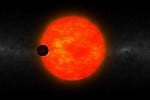Researchers have discovered a huge exoplanet, about the size of Jupiter (317.8 Earth mass), orbiting super-close to a small cool star approximately 500 light years from our Solar System. They say the new discovery challenges ideas about planet formation. They cannot explain how it got so close.
George Zhou, who works at the Research School of Astrophysics and Astronomy at The Australian National University (ANU), said:
“We have found a small star, with a giant planet the size of Jupiter, orbiting very closely. It must have formed further out and migrated in, but our theories can’t explain how this happened.”
Over the last twenty years more than 1,800 exoplanets – planets outside our Solar System orbiting a star – have been discovered.

The huge exoplanet, HATS-6, is the size of Jupter, it orbits a star that emits one-twentieth the light of our Sun, at a distance one-tenth that of Mercury to our Sun. (Image: anu.edu.au)
The researchers published their discovery in The Astronomical Journal (citation below).
M-dwarf stars common but poorly understood
This giant planet, called HATS-6, orbits an M-dwarf star, which is one of the most common types of stars in the Milky Way.
Even though M-dwarf stars are very numerous, scientists do not know much about them. They are cool, which means they are also dim, making them hard to study.
Our Sun emits twenty times as much light as HATS-6 does. Astrophysicists knew there was a planet orbiting it because there was a dip in its brightness that occurred as the planet passed in front of the star, observed by the ANU Siding Spring Observatory’s small robotic telescopes.
To confirm that the signal really was a planet and not just a blip in the system, Dr. Andrew Bayliss, from ANU’s College of Physical & Mathematical Sciences, asked for help from amateur astronomer T. G. Tan, who lives in Perth, and the Magellan Telescope in Chile, one of the largest telescopes in the world.

George Zhou at the Hawaiian Mauna Kea observatory. (Image: anu.edu.au)
Mr. Zhou said:
“T. G. Tan has been really helpful on our projects. He was able to catch the transit of the planet from Perth, after it had set over our horizon.”
Subsequent observations, from the Magellan Telescope and spectra taken from the ANU 2.3 metre telescope at Siding Spring, confirmed that this huge planet had an orbit of just one-tenth that of Mercury, our Sun’s closest planet.
HATS-6 orbits its star once every 3.3 days.
Citation: “HATS-6b: A Warm Saturn Transiting an Early M Dwarf Star, and a Set of Empirical Relations for Characterizing K and M Dwarf Planet Hosts,” S. Ciceri, J. D. Hartman, D. Bayliss, R. Brahm, B. Schmidt, G. Á. Bakos, L. Mancini, A. Jordán, K. Penev, M. Rabus, G. Zhou, R. W. Noyes, R. P. Butler, N. Espinoza, M. de Val-Borro, W. Bhatti, Z. Csubry, T. Henning, P. Arriagada, S. Shectman, J. Crane, I. Thompson, V. Suc, B. Csák, T. G. Tan, J. Lázár, I. Papp, and P. Sári. The Astronomical Journal. Published 28 April, 2015. DOI: 10.1088/0004-6256/149/5/166.

